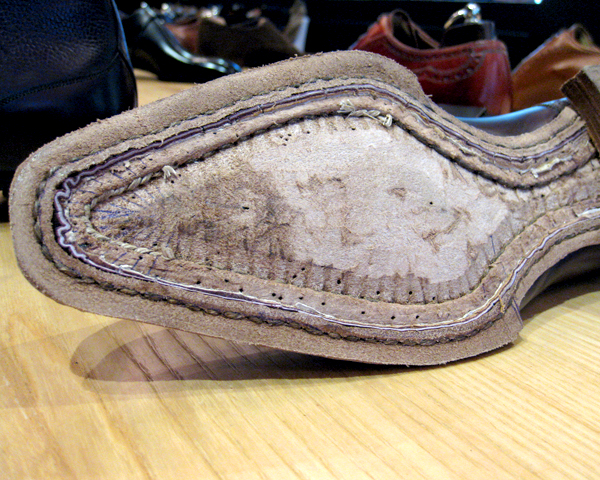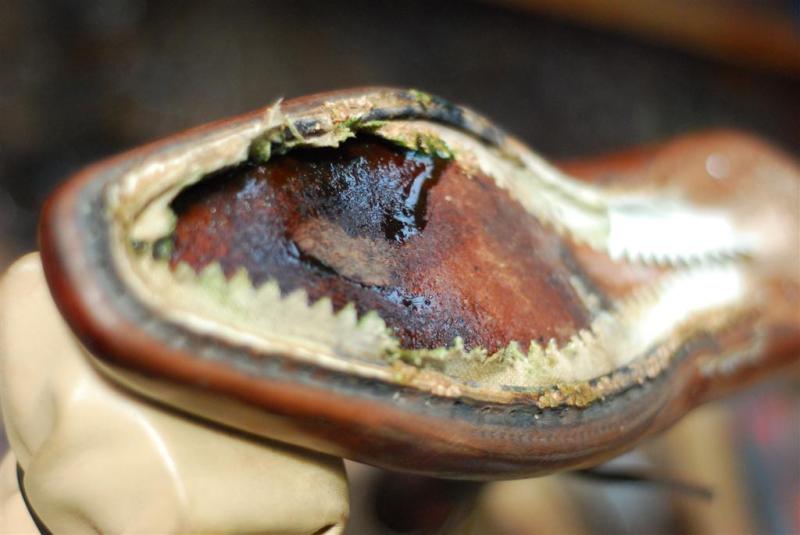Shoe Gemming Construction
7March 31, 2013 by Ville Raivio
Gemming is a construction method widely used by shoe factories since the 1950’s. In fully handmade shoes the cordwainer pierces a channel through the insole, and stitches the welt through the insole to the upper. The outer sole, in turn, is attached to the welt with lock-stitching. With this method completed, the outer sole — subject to most wear and abrasion — is ultimately kept in place by the insole. Gemming is a different animal entirely. Instead of piercing the insole, the outer sole is simply attached to a strip of canvas glued and cemented to the insole. In place of stitches to the insole, the shoemaker has placed a gluejob. Its benefits are manifold. Instead of using hours to carefully pierce and stitch the insole, gluing is fast and effective. The factory production is expedited as less shoemakers are tied to the slow manufacturing phase, and the customer receives his pair faster and with a cheaper end price.
Products from Pukimo Raivio
Ralph Lauren, Black Label suit, size 52EU
Hand-welted bespoke shoes by Gaziano&Girling
Cordwainer D.W. Frommer II defines the method as follows: “Gemming is a process that involves laying down a canvas rib around the perimeter of the under-surface of the insole. The rib is called gemming. And its purpose is to substitute for the leather holdfast…and to do it cheaply and quickly. It can be recognized by the white strip you see in most photos…sometimes ‘pinked’ sometimes not. The gemming is cemented to the insole. That is the only thing holding it (and the shape of the shoe) in place. The welt is machine stitched to the gemming and the resultant insole cavity is filled with cork.
Now, it bears repeating…in almost all instances, the gemming is held in place solely by cement. And that is its first weak spot. The cement will fail, probably even before the shoe is in need of a resole. When the cement fails the gemming slips and the shoe will walk out of shape. And anyone attempting to resole without the original last, faces the nearly impossible task of trying to re-position the gemming.” In short, gemming is a substitute for hand-welting, used to hasten production and profits, while guaranteeing a certain level of attachment — and yet Janne Melkersson, a third-generation cordwainer from Sweden, has repaired gemmed shoes for several decades without a single failed gemming experience. Millions of gemmed pairs have been produced since the 1950s; factories would have surely abandoned the method if failures were wide-spread.
Gemmed pair with white canvas rib by Edward Green
Gemming is the go-to method of shoe factories and price alone is no proof of quality welting. Factories like Alfred Sargent, Gaziano&Girling, Edward Green, Ludwig Reiter, John Lobb Paris, Alden and Carmina use gemming. All cheaper footwear, like Loake, Allen-Edmonds or Barker, all either gemmed or entirely glued. Instead of listing the makers using gemming, it is much easier to simply mention some hand-welters. These can be found below, though the list is far from quintessential. British factories have opted for gemming due to high labour costs, while Italian and Hungarian makers still benefit from cheaper labour, which allows them to offer true handmade shoes for lower prices. Some makers based in higher-wage countries have their production elsewhere. The German firm of Heinrich Dinkelacker has its pairs made in Hungary, Saint Crispin’s in Romania. Meermin is the odd man out: while the factory is based in Spain, its labour-intense workphases are outsourced all the way to China. I wager more makers will choose this model in the future.
The question remains whether gemmed footwear can be recommended. Based on my experiences and what I’ve read of the construction method, I can, yet I must remind the reader of the benefits of hand-welting. These pairs have no glue strip subject to rot, wear or random entropy. They are held in place by waxed linen thread, first on the welt, then — and ultimately — on the insole. The attachement is strong and guaranteed by a few thousand years of shoemaking experience. Still, the glues used by current factories are strong gunks, and I’ve never managed to destroy a gemmed shoe with walking alone. Most likely gemming will not fail, but it just might, and this possibility alone is enough to mark it inferior in the eyes of shoe nerds. For everyone else, gemming is the most useful tried and tested method available.
Some true hand-welters:
- all cordwainers
- László Vass
- Rozsnyai
- Buday
- Koronya
- Heinrich Dinkelacker
- Zonkey Boot
- Meermin
- Saint Crispin’s
- Silvano Lattanzi
- Kiton
- Lidfort
- Antonio Meccariello
- Sutor Mantellassi
- Bontoni
- Borgioli
- Mannina
- Stefanobi
Further reading:
- http://www.styleforum.net/t/153269/deconstructed-fashion-plate/0_100
- http://www.depiedencap.eu/spip.php?rubrique50
- http://www.styleforum.net/t/153448/gemming-the-shoe-devils-work/0_100
- http://www.askandyaboutclothes.com/forum/showthread.php?100133-What-seperates-Crocket-amp-Jones-from-Edward-Green/page2
- http://forums.filmnoirbuff.com/viewtopic.php?id=6446
Photos: original uploaders
Category Footwear, Glossary | Tags:





I’m taking in a two pairs of Canadian made Matthew Dack’s to the cobbler for resoling today. Both are Goodyear welted and both pairs are about 25 years old. After reading this article I cut the stitching on one of the shoe to reveal the bottom of the insole. The cork is dry and crumbly but the gemming is pliable and well bonded. This is only a sample size of one, but it is still informative to me. Cheers!
It is years late but as for gemming failures take a pair of original lasted DrMartens (not the comfort), saw a few failure right there, the rib ripping off the portion of ribbon that was glued for some with wide feet, the glue letting go in older pairs.
Hello there,
I have no idea about this. Perhaps you should leave a question at Shoegazing.se – it’s a great shoe blog.
Hi Keikari,
I am very interested on trying to make shoes with Gemming rib and thank you for your great info on this site. Do you know where I can buy the ribbon or the gemming material in Europe?
Seams to be hard to find-Thanks
María
I’ve owned, and had resoled, many pairs of gemmed shoes and I’ve never had a gemming failure. Granted the oldest pairs I’d only worn for 15 years. Not a statistically valid sample, but all the same; it seems like a reasonable method of construction.
Greetings from Finland, Nick!
I have asked about gemmed pairs from several cordwainers and cobblers, who’ve repaired and re-soled shoes for several years. Janne Melkersson and Marcus Davidson are two examples. Gemming failure is rare and canvas strips can be replaced just like soles. Please bear in mind that Mr Frommer is only one man. What sets him apart is his knowledge and willingness to take part in online debates. These make him an authority, but still one among many. If you feel gemming will most likely fail, please visit your local cobblers and inquire further. I’m interested in this topic as well.
A nice article on most counts but it seems to me flawed in one critical respect. You say that it is most likely that gemming will not fail. But this directly contradicts what shoemakers say, in particular Frommer, who you quote, according to whom gemming failure is a matter of when, not if. What is your source for saying that gemming will most likely not fail? Do you have data? What?
Thanks,
Nick